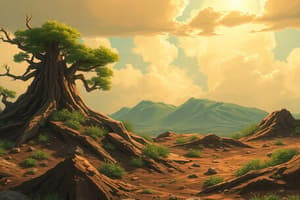Podcast
Questions and Answers
Which soil component contributes the most nitrogen to plants?
Which soil component contributes the most nitrogen to plants?
- Sand
- Humus (correct)
- Clay
- Silt
Which soil would most likely be found in the Arctic?
Which soil would most likely be found in the Arctic?
- Gelisols (correct)
- Andisols
- Spodosols
- Histosols
Which describe the effects of climate on the rate of weathering? (Check all that apply)
Which describe the effects of climate on the rate of weathering? (Check all that apply)
- Lower precipitation levels lead to more chemical reactions.
- Chemical reactions occur faster at higher temperatures. (correct)
- The chemical reaction rates of minerals are not impacted by temperature.
- Cold climates favor mechanical weathering. (correct)
- Warm climates favor chemical weathering. (correct)
Which best describes the soils found in the southeastern United States?
Which best describes the soils found in the southeastern United States?
Which describes the formation of Horizon B?
Which describes the formation of Horizon B?
Which contribute to both chemical and mechanical weathering? (Check all that apply)
Which contribute to both chemical and mechanical weathering? (Check all that apply)
Which are causes of mechanical weathering? (Check all that apply)
Which are causes of mechanical weathering? (Check all that apply)
Which describe the horizons in a soil profile? (Check all that apply)
Which describe the horizons in a soil profile? (Check all that apply)
Which are factors that scientists use to classify orders of soil? (Check all that apply)
Which are factors that scientists use to classify orders of soil? (Check all that apply)
Which increase the rate of soil formation? (Check all that apply)
Which increase the rate of soil formation? (Check all that apply)
Flashcards are hidden until you start studying
Study Notes
Soil Components
- Humus is the primary source of nitrogen for plants.
- Soil components include clay, humus, sand, and silt, with humus providing the most nitrogen.
Types of Soil
- Gelisols are typically found in Arctic regions, characterized by permafrost and a cold climate.
Climate Effects on Weathering
- Warm climates enhance chemical weathering.
- Cold climates favor mechanical weathering.
- Higher temperatures result in faster chemical reactions.
- Lower precipitation levels can decrease chemical reaction rates.
Soil Characteristics in the Southeastern U.S.
- Soils in the southeastern United States are often described as weathered, indicating they have undergone significant alteration.
Horizon Formation
- Horizon B undergoes the most change in soil profiles and reflects the impact of leaching and organic material.
- Horizon formation begins with organic matter accumulating in Horizon O and progresses downward.
Weathering Processes
- Chemical and mechanical weathering are driven by organisms and water, which contribute to the breakdown of rocks.
- Mechanical weathering can also be caused by factors like plant growth, animal actions, and pressure release.
Soil Profile Horizons
- Horizon O consists of organic material.
- Bedrock lies beneath all soil layers, providing the base for soil formation.
- Horizon C is the least affected by soil formation processes, preserving a closer relation to the parent material.
Soil Classification Factors
- Key factors for classifying soil orders include climate, plant type, and soil composition.
- Additional considerations can influence soil properties, though fertility and dryness are not primary classification factors.
Soil Formation Rate Enhancers
- Higher precipitation, warmer temperatures, and large grain sizes promote faster soil formation.
- Very hard parent material can inhibit the rate of soil development compared to softer substrates.
Studying That Suits You
Use AI to generate personalized quizzes and flashcards to suit your learning preferences.




